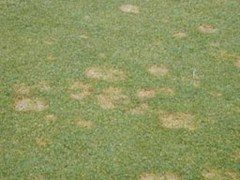
GreenCast Tech Notes Dr Ruth Mann STRI
Volume 1, Issue 4 - October 2007
Timing to Control Fusarium Patch
The temperature has suddenly dropped and autumn has come before summer really got started; Fusarium Patch, or microdochium patch as it is often now known, has very quickly come to the fore in recent weeks.
Mild, wet weather will encourage the spread of current disease and further outbreaks. fusarium patch is usually most severe on golf greens dominant in annual meadow-grass, but it can also attack bent and fescue severely, depending on conditions.

Photo by Bob Johnson
STRI research has shown the high levels of Fusarium control achieved with HERITAGE applications timed according to GreenCast disease forecasts, reports Dr Ruth Mann.
Fusarium patches may develop salmon-pink to orange-brown rings of conidia around the outside, with white, pink or grey mycelia growth in conducive conditions. As patches coalesce significant damage can occur, unless controlled with HERITAGE or BANNER MAXX.
The disease is commonly associated with high fertility situations and lush grass growth. However, judicious use of autumn fertilisers low in nitrogen and high on potassium may help improve the plants natural defences, without encouraging lush, susceptible growth. Iron can also be applied to help harden the plant and reduce the potential for infection.
The timing of fungicides for Fusarium Patch control is crucial. Fungicides which act as acropetal penetrants, such as HERITAGE (azoxystrobin), are much more effective when applied at high disease risk but before the onset of symptoms.
Research at STRI has shown that using GreenCast will help to predict when the forecasted weather is conducive to disease infection and optimise damage limiting preventative application timing. A dedicated indicator green can also help to predict when disease is coming. As soon as spots appear on the indicator green, all other greens should be treated preventatively.
Curative fungicide control should be applied at the very first signs of infection. DACONIL WEATHER STIK (chlorothalonil) is very effective applied curatively. Symptoms should not be allowed to develop into larger patches before treatment, since it is very difficult to obtain recovery from damage during the winter months, when grass growth is slow - even after fusarium pathogen (microdocium nivale) has been controlled with a fungicide.
